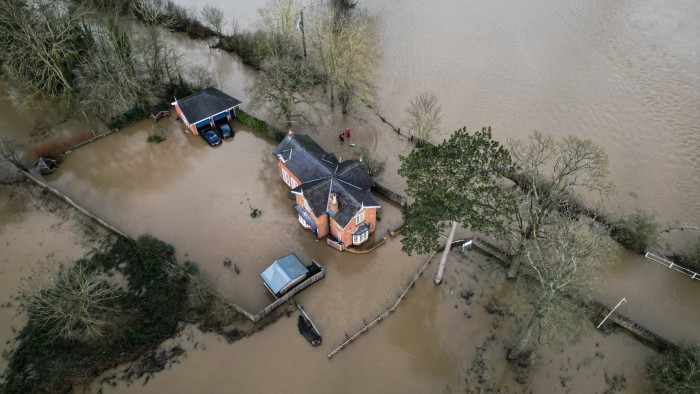Stay informed with free updates
Simply sign up to the Climate change myFT Digest — delivered directly to your inbox.
Banks and insurers have “gaps” in how they address climate change risks, such as flooding and extreme weather, the Bank of England has warned, but fixing them will hamper lending to some households and companies.
The BoE’s Prudential Regulation Authority has instructed banks and insurers to do internal reviews on climate risk and said it would check how the guidelines were being put into effect six months later.
Some UK banks do not have climate-related data on where their borrowers have property, leaving them unable to assess their vulnerability to floods, heatwaves or wild fires, the PRA said.
No British lenders were able to fully quantify how climate change would affect their activities in different scenarios, it said, adding that most did not consider the issue a material danger except for the “reputational risk” of being associated with funding fossil fuels.
The financial institutions could be exposed to losses that “undermine their safety and soundness”, the PRA said on Wednesday, unless they addressed the shortfalls in climate risk preparation.
The watchdog published updated guidance on what it expects in the assessment of both physical risks, such as floods, as well as so-called transition risks stemming from the shift away from carbon emissions.
The central bank guidance indicates it maintains a focus on climate-related risk, despite the backtracking on climate change policy by many companies and some leading western governments over the past year.
The EU has watered down its sustainability reporting requirements, while US President Donald Trump has reversed many of the climate and clean energy policies of his predecessor Joe Biden. The US Federal Reserve recently withdrew from the central banks in the Network for Greening the Financial System.
The PRA’s move comes as an independent UK government adviser separately warned on Wednesday that the country’s progress on adapting to climate change was “either too slow, has stalled, or is heading in the wrong direction”.
David Bailey, executive director for prudential policy at the PRA, said “considerable progress has been made” in tackling climate risks at banks and insurers, but added: “There is still more to do, and it remains critical that firms continue to focus on these risks.”
Tackling these gaps would cause people who live in areas prone to flood risk to face higher mortgage rates and insurance costs. “In the extreme”, it said, that could “lead to loss of mortgage availability in some localities of the UK”.
It said this could also push up funding costs for companies with high carbon emissions, adding: “This could in turn deter economic activities in those sectors.”
Insurers had generally treated climate change more like a box-ticking exercise than a strategic risk, the PRA said, adding it had found “limited evidence that results are being used in decision-making”.
Insurers had also excluded “tail risks” from their scenario analysis, the PRA said, and had focused on physical and legal risk but had “very rarely” considered risks stemming from the impact of the economy’s transition to net zero carbon emissions.
However, British insurers are pushing the government to do more to reduce flood risk after large payouts on weather-related damage to people’s homes and possessions last year.
“We continue to urge the government to commit to an annual investment of at least £1bn a year in flood defences as part of its upcoming spending review,” said Louise Clark, manager of general insurance policy at the Association of British Insurers.
https://www.ft.com/content/74c87a85-d808-46e8-9bcf-d0028b2afde9


